Automotive industry in the Philippines
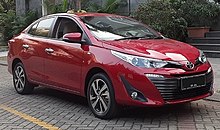
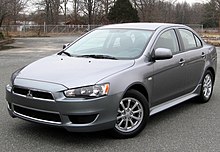

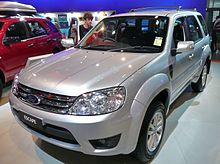

The automotive industry in the Philippines is the 9th largest in the Asia-Pacific region, with approximately 273.4 thousand vehicles sold in 2019.[1] Most of the vehicles sold and built in the Philippines are from foreign brands, for the most part, the Philippines is dominated by Japanese automobile manufacturers like most of its ASEAN neighbors.[2] The automobile production in the country is covered under the Philippine Motor Vehicle Development Program being implemented by the Board of Investments.[3] In addition, there are also a small number of independent firms who assemble and fabricate jeepneys and other similar vehicles, using surplus engines and drivetrain parts mostly from Japan.
The Philippine automobile industry consists of two sectors: motor vehicle assembly and vehicle parts and components manufacturing. The country also has an active premium car market and commercial vehicle segment.
Automobile sales in the Philippines mostly consist of locally assembled and imported cars, notably coming from Thailand, Indonesia, and from other countries. In 2019, the average cost difference of an imported vehicle coming from Indonesia was 24 percent lower than a locally produced car. The same cost difference applied to completely built-up cars from South Korea (also 24 percent) and Thailand, with 18 percent.[4] The country also imports cars coming from China, India, and the United States.
History[]
The Philippines' automobile industry started during the American colonial period from 1898 to 1946. Filipinos were used to riding animal-pulled vehicles, and wealthy citizens were initially the ones who could afford to buy and own these newly introduced automobiles. Back in those days, on average, it took at least three months to ship an automobile from Europe or the USA, to Manila.
Cars and motorcycles were introduced and made available in the country by trading companies as early as 1901, with Dr. Juan Miciano, being acknowledged as the first Filipino to buy and operate a motor vehicle. He drove a French-made Richard-Brasier in which he bought back in 1901, according to a 1910 motor car directory.[5] Although prior to that, back in December 1900, the US Army Signal Corps had brought in a number of electric cars by Woods Motor Vehicle Company into the country for military use only. It marked the early appearance of motor cars in the country.[6]
In the early days of the Filipino automobile market, American-made cars from Mercury, Buick, Chevrolet, Ford, and Dodge have dominated the car market from the 1920s all the way to the early 1970s. And the country pioneered the establishment of the automotive assembly in the Southeast Asian region. An import substitution policy was developed for the 1950s, which led to the prohibition of and then punishingly high tariffs on the import of fully built-up cars from 1951 until 1972.[7]
American and European-made cars were a common sight on the country's road by the 1960s. In that same decade, Japanese-made cars were introduced in the market. The country's auto industry was on the number one spot in the entirety of Southeast Asia during that period. By the mid-1960s, fuel economy and practicality began to become important criteria for a growing number of car buyers in the country. The Japanese car manufacturers were at the forefront of cars that feature fuel economy and practicality. At this point, American car manufacturers like General Motors turned to their European and Australian subsidiaries Vauxhall and Holden, to bring in the mid-size and compact cars to compete against Japanese marques in the growing car market.[8]
Localization[]
In the 1970s, local production of automobiles in the Philippines began in 1975 with mostly passenger and some commercial vehicles. During the 1973 oil crisis, then President Ferdinand Marcos advised Filipinos to buy smaller, more efficient vehicles with four-cylinder engines. In which demand for full-size American sedans fell in favor of economical, reliable, affordable, small, and practical cars. By the mid-70s, the popularity of full-sized American cars had quickly dwindled and the compact, subcompact, and some mid-sized cars have quickly become popular ever since then.
In 1973, the government instituted the Progressive Car Manufacturing Program (PCMP), a system with scheduled increases in local parts content requirement which also allowed program participants to import a certain proportion of completely built-up vehicles.[7] The original participants were General Motors, Ford, PAMCOR (a Chrysler/Mitsubishi joint venture), Delta Motors Corporation (Toyota), and DMG Motors (Volkswagen). A local Volkswagen assembler, DMG, attempted to build a native national car, the Volkswagen Sakbayan (a portmanteau of sasakyang katutubong bayan, "original national vehicle") as well as the Trakbayan light truck.[9] This project, however, did not last long. The Sakbayan was based on the Volkswagen Country Buggy.[7]
During the 1980s, the mid-size, compact, and subcompact Japanese and some European cars became dominated the Philippine market. However, by 1985, several car manufacturers closed and left the Philippine market, leaving Nissan and Mitsubishi in the market. By 1985, due to economic hardships, cars like the Nissan Stanza and Mitsubishi Lancer were the only choice left for car buyers back while most drove older cars. And the Philippines automobile industry fell drastically, what was once known as the leading automotive industry in the 1960s in Southeast Asia failed due to an economic downturn in the 1980s. In this era, Thailand has been known as the "Detroit of Southeast Asia" since their industry ranks 12th in the whole world and currently the largest in Southeast Asia. Towards the end of the '80s, some car manufacturers including Mitsubishi, Nissan, and Toyota, resumed business operations in the Philippines in 1988. With the recovery of the country's economy from the 1980s until the mid-1990s, the automotive industry in the Philippines recovered with local vehicle manufacturers hitting 138,000 units in 1996. This figure is 85 percent of the domestic vehicle sales of the period.[10]
After Marcos[]
The original PCMP (Toyota, Mitsubishi, Nissan) members returned in 1988 after the People Power Revolution ousted Marcos in 1986, and eventually, no less than thirteen manufacturers vied for a market limited to around 100,000 cars per year.[7] During the 1997 Asian financial crisis, several makers withdrew as sales declined, becoming de facto CBU importers rather than assemblers. Since 1998 the Philippine automotive manufacturing policy has been in flux, severely undermined by the preponderance of lightly used cars from Japan and South Korea.[7] A new program was introduced in 2002, EO 156, actually undermined any local assembly by lowering the sales tax on the cheapest microcars, called "Bantam cars" in the Philippines, which are almost entirely imported from other ASEAN countries or China. Meanwhile, the popular locally assembled AUVs with high Philippine parts content were hit with considerable sales tax increases due to their bigger engines and higher up-front prices.[7]
The total industry sales plummeted anew to five digits annually from 1998 to 2006. It was only in 2007 onwards the automobile industry sales begin to climb to pre-crisis levels, where the total industry sales reached 144,435 units.[10] Production of completely knocked down cars remained stagnant after the 1997–1998 economic crisis, and since 2008, CBU imports outnumbered the locally assembled cars.[10]
The 2010s were seen as a great decade for the automobile industry in the country, with new car brands and vehicle models arriving for the local market. From 2015 onwards, the country's automobile market has been progressing.
The automobile industry in the Philippines is struggling due to the COVID-19 pandemic. Even before the pandemic, sales were greatly affected due to the 2020 Taal Volcano eruption. Although sales are recovering, the local automobile industry's monthly average sales performance is still way below the figures.
Government programs[]
Progressive Car Manufacturing Program (PCMP)[]
In 1973, President Ferdinand Marcos signed the Progressive Car Manufacturing Program (PCMP). Originally 4 car manufacturers were chosen to be part of the program, but Ford Motor Company was determined not to be left out. Ford proposed to the government that, if included, Ford would provide a stamping plant. After an 11-hour proposal, the deal was settled and PCMP ended being a five-participant venture.[11] The program consisted of Delta Motors Corporation/Toyota, General Motors Pilipinas, Ford Philippines, DMG/Volkswagen, and Chrysler Philippines- a joint venture of Mitsubishi and Chrysler.
The first Asian Utility Vehicles (AUV, local versions of the Basic Utility Vehicle project then in vogue) was made with full manufacturing and assembly capabilities, each of the five PCMP participants was spurred to produce vehicles completely from local materials, designed for local needs. In terms of design, all AUV's body parts were flat stamped (no compound curves) which require a minimum investment in tooling and simplifying repairs. The most successful of the AUV's in the country were the Toyota Tamaraw and Ford Fiera. From the chassis cab, Ford and Toyota designed numerous body styles for specific uses for small businesses such as farmers and fishermen. Affordability was a target for all AUV's. To solve this, Ford prepared project studies for varied uses. They had a financial arrangement with Citibank to give additional consideration if the applicant would follow the project study.[7]
The other remaining 3 car manufacturers that are also part of the PCMP Program made their own AUV to compete with the local market, it included the Mitsubishi Cimmaron (which was largely replaced by the Mitsubishi L300 in the Philippines), DMG/Volkswagen Sakbayan, GM Harabas, Isuzu KC20 and Nissan Bida. Initially, the Bida was going to be a fourth-generation Ford Fiera, but as a result of Ford leaving the market in 1984, Nissan bought the rights to the Fiera and sold it as a Nissan. Delta/Toyota also developed a local SUV mainly for military use, the Delta Mini Cruiser. After the early 1980s financial collapse, 2 out of 5 of the PCMP members withdrew, leaving only Nissan and Mitsubishi. The program was considered to be a failure, as stated by the then prime minister of the Philippines, Cesar Virata. He also admitted that since 1975, not one of the five participants in the PCMP had produced a car that could be considered "Made in the Philippines."[11] Vehicles such as the Ford Fiera, was being assembled at Ford Lio Ho Motor in Taiwan, while the Toyota Tamaraw was known of its Indonesian origin.
Toyota Tamaraw

Nissan Bida

Delta Mini Cruiser
Car Development Program (CDP)[]
In 1987, PCMP was replaced by the new "Car Development Program" (CDP), with lower local parts requirements. The original participants of the program were Mitsubishi, Nissan, and Toyota, when they went back into business in 1988.[10] This program made car manufacturers to build up local assembly plants. In 1990, the addition of the People's Car Program to the CDP paved the way for the entry of new car manufacturers such as Honda, Kia, and Fiat.[10] Honda, Kia Motors, Fiat, and later Proton built assembly plants in the country, which saw Honda assembling the Honda Accord, Honda Civic, Honda CR-V and Fiat assembling the Fiat Uno, Kia assembling the Kia Pride, with and Proton assembling the Proton Wira as well as a couple of Volkswagen vehicles for the local market. A Luxury Car Program was also added in 1992 as part of the CDP amendment. It saw the entry of Volvo, BMW, and the re-introduction of Mercedes-Benz. Volvo 850s and the BMW 3 Series (E36) were also being assembled in the country as semi-knocked kits.[12]
Public Utility Vehicle Modernization Program (PUVMP)[]
The Public Utility Vehicle Modernization Program was launched by the Department of Transportation of the Philippines in 2017, with the goal of making the country's public transportation system efficient and environmentally friendly by 2020. The program features ten components which include regulatory reform, route planning, route rationalization, fleet modernization, industry consolidation, financing, pilot implementation, stakeholder support mechanism, and communication.[13] The program calls for the phasing-out of jeepneys, buses, and other public utility vehicles (PUVs) that are at least 15 years old and replacing them with safer, more comfortable, and more environmentally-friendly alternatives over the next three years. Manufacturers like Hyundai, Isuzu, Hino, Mitsubishi Fuso, Mahindra and Russian brand GAZ have participated to build modern PUVs based on their existing van, truck and bus lineups to replace the aging Jeepney.
Comprehensive Automotive Resurgence Strategy (CARS) program[]
The CARS Program was implemented by the Department of Trade and Industry in order to attract and encourage new car companies to produce vehicles in the Philippines[14] and stimulate demand and impose industry regulations that will restore the country's automotive industry, and make the country a regional automotive manufacturing hub,[15] and creating more jobs in the country.
The program was considered unsuccessful since most car manufacturers see the Philippines as a market of vehicle importer rather than an exporter. Most car manufacturers would build assembly plants in Thailand, Indonesia, Malaysia, Vietnam, and China since their corporate taxes, operations setup and costs are lower.[14] There are more major parts suppliers that have set up facilities in these countries, meaning importing parts is not needed.[14] Other factors include minimum wages and electricity costs, which are also slightly lower compared to the Philippines.
So far, only two Japanese car manufacturers, Mitsubishi and Toyota, have taken part in the program. The program initially had the capacity for three car manufacturers, but no other automaker has participated to take up the third position.[16] Mitsubishi was approved by the government under the CARS program in 2016[17] and announced the local production of the Mirage and Mirage G4 in 2017.[18] Toyota Motor Philippines has been manufacturing the Toyota Vios since 2013 and enrolled the facelifted Yaris ATIV-based Vios to be locally manufactured. Both manufacturers have a target to produce 200,000 vehicles within 6 years.
Price differences on imported cars coming from Indonesia or Thailand have been reported to be much lower compared to a locally assembled car. This is because the country does not impose tax incentives on imported cars. Unlike Thailand, it has preserved its automobile industry by giving an advantage with tax incentives on the locally-made vehicles,[14] meaning 4 out of every 5 cars sold are complete built-up (CBU) imports and only about 1% of vehicles are locally assembled.[14] This resulted in the closing of assembly plants of Ford in 2012, Honda in 2020, and Nissan in 2021, while Isuzu decided to stop local production of the Isuzu D-Max in 2019 meaning cars from their lineup will be imported from elsewhere.
Safeguard Measures Act[]
In 2021, the Department of Trade and Industry has enacted laws on import safeguards on automobiles in a bid to protect the domestic automobile business. This was made as a response to the petition filed by Philippine Metal Workers Alliance asking for safeguard measures against the dominance of fully imported automobiles versus locally assembled models.[19] Many car manufacturers, have shown concern that the import tariffs would hurt the local car industry as they rely heavily on imported cars from other countries such as Indonesia and Thailand. Although vehicles that are exempt to this rule are vans/commercial vehicles that have more than 10-seating capacity, electric vehicles, locally assembled vehicles, and most luxury cars.[20] DTI Secretary Ramon Lopez announced that the country would start imposing a 70,000 PHP ($1,460) tariff on passenger cars and 110,000 PHP ($2,262) on light commercial vehicles.[21] Cars coming from Thailand, USA, Japan, and Europe are subject to this rule. Though some countries like the People's Republic of China, South Korea, Malaysia, and partially Indonesia are exempted from this rule.
However, on 6 August 2021, the imposition of safeguard duty on imported vehicles was suspended. As the Tariff Commission determined that there is no surge on fully imported vehicles. Given that completely-built passenger cars and light commercial vehicles were not imported in greater quantities during the investigation period, the Commission closes its formal investigation and recommends that no safeguard measure be imposed on imports of the CBU passenger cars and light commercial vehicles under examination will not face any definitive general safeguard measures. Once the order is published, it will be transmitted to the Department of Finance, which will then direct the Bureau of Customs to lift the DTI's safeguard measures.[22] The decision to lift the DTI's safeguard restrictions on imported cars, which account for the vast majority of vehicles sold in the Philippines, will significantly help the industry recover.[23] While the implementation is waiting for a full effect, car dealerships across the country will return cash deposits paid by consumers who purchased the imported vehicles during that time period.
Active manufacturers[]
Notable Filipino automotive manufacturers include Sarao Motors and Francisco Motors Corporation.[24]
As of February 2021, there are 58 official car brands in the country.
BMW[]
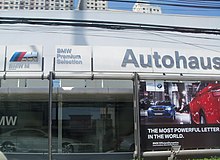
Between 1994 and 1997, the BMW 3 Series (E36) was being assembled locally by SKD kits.
BMW Philippines is currently an owned subsidiary of San Miguel Corporation, and the official importer and distributor of BMW vehicles in the country.
Ford[]
Ford's history in the Philippines can be traced back to 1929. Ford Philippines, Inc. (FPI) was established as a subsidiary of the Ford Motor Company in 1967 and began production operations on May 3, 1968. Ford left the market in 1984 due to the local economic recession. The brand came back in 1997 as Ford Motor Company Philippines, Inc. (FMCPI). Ford built a manufacturing plant that opened in September 1999. During its lifetime, the plant has provided Ford and Mazda products like the Ford Lynx, Ford Escape/Mazda Tribute, Ford Focus, Mazda3, and the Mazda-based Ford Ranger not only for the local market but also neighboring countries such as Indonesia, Vietnam, Thailand, Malaysia, and Singapore.[25] The plant closed down in 2012. Since then, Ford Philippines imports the vehicles it sells mostly coming from Thailand and the United States to the Philippine market. Ford Philippines also used to sell Lincoln cars in the country. Their former plant in Santa Rosa, Laguna is now owned by Mitsubishi Motors Philippines.
General Motors[]
Chevrolet’s operation in the country is under the control of The Covenant Car Company Inc. GM engaged a partnership with The Covenant Car Company, Inc. (TCCCI), appointed by GM Southeast Asia as an independent and exclusive importer and distributor of Chevrolet automobiles and parts in the country. TCCCI was officially incorporated on July 1, 2009, and assumed business operations on October 1, 2009.
With the partnership of GM, they launched GM Philippines, Inc. on December 1, 2014.[26] Most of the cars in Chevrolet's lineup were imported from Thailand, the US, and South Korea.
Prior to that, Yutivo Corporation was responsible for the production and manufacturing of General Motors products in the country. Originally founded in 1887, Yutivo has been in charge of assembling Chevrolet, Opel, Holden, Vauxhall, Buick, and even Isuzu cars and trucks in the country.[27] They became a spare parts distributor for General Motors in the country back in 1940. Yutivo then started assembly operations in 1953 and stayed in business until 1976.[28]
General Motors also built two Asian Utility Vehicles (AUV), called the GM Amigo/Tiger and the GM Harabas. These used the underpinnings of the Bedford HA and a 1256 cc Vauxhall inline-four engine. The Harabas was a four-door station wagon (mainly used as a taxi) and replaced the very basic Amigo/Tiger truck.[29]
Isuzu[]
Isuzu's Philippine debut came in the 1950s through its line of trucks. In 1972, General Motors and Isuzu formed a joint venture during the 1970s to create GM Philippines. In 1989, Isuzu Motors Pilipinas became a subsidiary of Isuzu Motors Ltd. Since 1995, it was renamed Isuzu Philippines Corporation. Aside from trucks, it also produced SUVs, MPVs, and pick-up trucks such as the Trooper, Hi-Lander (and later, the Crosswind), Fuego, and the D-Max. The company has been exclusively making trucks as they have discontinued producing passenger vehicles. Discontinuing the production of the Crosswind in 2017,[30] and the local production of the D-Max in 2019.[31] Meaning the D-Max would now be imported from Thailand.
Honda[]
Honda Cars Philippines Inc. (HCPI) was established in October 1990. Under the Philippine government's Car Development Program, production operations commenced in February 1992. To date, HCPI is a team of over 600 associates, working with 38 dealers nationwide and about 60 parts and materials suppliers. Their assembly plant is located in Santa Rosa, Laguna.
In March 2020, HCPI announced that it would cease production operations at its plant in Santa Rosa, marking an end to 27 years of production.[32] Since then, most cars will be imported into the Philippines from nearby Southeast Asian countries including Thailand and Indonesia.
Hyundai[]
Hyundai Asia Resources, Inc. (HARI), is currently the official distributor of Hyundai passenger cars and commercial vehicles in the Philippines, they were appointed by Hyundai Motor Company of South Korea in August 2001 as the official distributor of Hyundai vehicles in the Philippines. It had earned its spot as the third top player in the Philippine automotive industry. There are currently 42 dealerships around the country. Their plant in Santa Rosa, Laguna currently produces the Hyundai Accent, Hyundai H100, and the Hyundai H350. Hyundai first entered the Philippine market selling the Hyundai Excel and the Hyundai Grace van in the early 1990s. Later introducing the Hyundai Starex and the second generation Hyundai Elantra towards the end of the decade.
Recently, the company expects further sales to be boosted by its Hyundai Modern Jeepneys with the implementation of the Public Utility Vehicle Modernization Program. HARI targets to sell more modern jeepneys as the government pushes for the Public Utility Vehicle Modernization Program to replace the aging Jeepneys.
Kia[]
Kia began its operation in the Philippines in May 1994 under the management of the Columbian Autocar Corporation. It assembled the Kia Pride hatchback and sedans as part of the Car Development Program. It also assembled the Kia Ceres (and the later Kia Besta vans), and the Pregio. Since 2019, Kia Philippines has been managed by the Ayala Corporation.[33]
Mazda[]
Mazda was introduced in the Philippines in 1993 by its distributor Columbian Autocar Corporation. It assembled the 7th and 8th generations of the Mazda 323 (In which both generations were sold alongside each other). In the 2000s, the Mazda3 and the Mazda Tribute were assembled at Ford's Santa Rosa plant under the partnership with Ford Motor Company. Berjaya Auto Philippines is the current importer and distributor of Mazda's vehicles in the country and has its own warehouse for storing vehicles located in Cabuyao, Laguna.[34]
Mercedes-Benz[]
Mercedes-Benz was established in the 1990s under the Luxury Car Program. But prior to that, the brand has been in the country since the 1950s, assembling the Ponton, Mercedes-Benz W110, Mercedes-Benz W114/W115 and the Mercedes-Benz W123.[12] Currently, Auto Nation Group, Inc. (formerly known as CATS Motors, Inc.) is the general importer and distributor of Mercedes-Benz vehicles, parts and accessories in the Philippines. Its history traces back to 1989 when its founder Felix R. Ang opened CATS, car accessories and tires sales and servicing business. In 1991, Mercedes-Benz appointed CATS Motors as an authorized workshop in the Philippines, and eventually as a dealer in 1993. Auto Nation Group (ANG) is also responsible of selling Chrysler, Dodge, Jeep, and RAM vehicles in the country.
Mitsubishi[]

Originally established as Chrysler Philippines Corporation in 1963 as the assembler and distributor of Chrysler, Dodge and Plymouth cars in the Philippines. The company was incorporated in 1987 as Philippine Automotive Manufacturing Corporation (PAMCOR). Since 1996, the company was renamed Mitsubishi Motors Philippines Corporation (MMPC). Its former assembly plant is located in Cainta, Rizal, operating from 1963 to 2014. Since 2015, its current location is in Santa Rosa, Laguna.
Nissan[]
Nissan started in 1969 with the appointment of Universal Motors Corporation (UMC) as the authorized assembler and distributor of Datsun cars and pickups in the country. In 1983, Nissan Motor Company established Pilipinas Nissan, Inc. (PNI) to assemble and distribute Nissan passenger cars. The company was renamed Nissan Motor Philippines, Inc. (NMPI) in 1991. In September 2000, the Yulon Motor Co. took control of NMPI from Nissan Motor Company. Since 2013, the company has now been known as Nissan Motor Philippines (NPI).
In 2021, Nissan Philippines announced that it will be shutting down its Santa Rosa plant by March, effectively ending the Nissan Almera assembly operations.[35]
Subaru[]
In 1996, Columbian Autocar Corporation introduced Subaru in the Philippine market. The brand later withdrew in 2000 due to poor sales but later returned in 2006 under the new management. The current official importer and distributor of Subaru vehicles are Motor Image Pilipinas Inc, a subsidiary of Tan Chong International.
Toyota[]
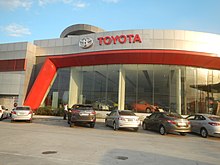
Established on August 3, 1988, Toyota Motor Philippines is a subsidiary of Toyota Motor Corporation, based in Santa Rosa, Laguna, Philippines. They are responsible for the assembly and distribution of Toyota vehicles in the Philippines since 1988. And since 2009, TMPC also a provider to Lexus Manila, Inc., the official distributor of Lexus cars in the country. TMPC is the largest automotive company in the country, with the widest vehicle line-up of 21 models and a sales distribution and service network composed of 63 dealerships nationwide. Prior to that, Toyota vehicles were being sold in the country since 1962 by Delta Motors Corporation. They were responsible for assembling and distributing Toyota vehicles for the Philippine market. Delta Motor Corporation collapsed during the Philippine economic downturn in the early 1980s, which meant Toyota was not present in the market for four years.
Volkswagen[]
Domingo M. Guevarra Sr and his company, DMG Inc., was responsible for importing, production, and assembly of Volkswagens in the Philippines. The Volkswagen Kombi, Volkswagen Beetle and the Volkswagen Brasilia were some of the models built by DMG.[12] DMG was also known for its DMG-Volkswagen Sakbayan, in an attempt to build a national car, is based on the Volkswagen Country Buggy. DMG went bankrupt in the mid-80s. And Volkswagen later came back in the 1990s, selling the Volkswagen Polo Classic from 1996 until 1999. The Polo Classic, alongside the Caravelle was locally assembled in Alaminos.[36] In 2013, Volkswagen returned to the Philippine market with the partnership of Ayala Corporation.
In 2018, Volkswagen PH discontinued their international models such as the Jetta, Passat and the Golf GTS in favor of Chinese-sourced models like the Santana, Lavida, and Lamando as part of the new ASEAN-China Free Trade Agreement.[37] The reason for the shift was to reduce tax by 5%.[38] The decision sparked negativity to the brand, mostly contributed by the South China Sea Arbitration, with Volkswagen reporting low sales in the country - with only 177 cars sold in 2019.[39] But Felipe Estrella III, the president of Volkswagen Philippines emphasized that "regardless of the source, the product is the same".[40]
Currently, the Multivan Combi that was launched in the Philippines on July 2021, is the only non-SAIC Volkswagen product in its lineup.
Defunct manufacturers[]
Daewoo[]
Daewoo sold moderately in the country until it was forced to pull out due to the Asian Economic Crisis, which led to its bankruptcy and acquisition by GM. Today, many of their cars are sold under the Chevrolet brand. Though Daewoo Bus still operates and manufactures buses for the country.
Daihatsu[]
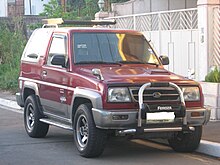
The Daihatsu Feroza was considered a status symbol during its release in the late 1980s, while the Hijet was a popular taxicab. The Daihatsu Charade was also a popular hatchback in the 1990s. Despite its absence, some of their cars today are sold under the Toyota brand. Cars like the Toyota Rush and the Toyota Wigo originated as Daihatsu models in Indonesia.
Fiat[]
Despite being a bestseller worldwide, the Fiat Uno sold poorly in the country. In mid-2018, Abarth was introduced into the Philippine market selling the Abarth versions of the Fiat 500. Petromax Enterprises, the distributors of the newly introduced brand in the local market, also reintroduced Alfa Romeo into the market, which was last seen back in the 1990s.
Lincoln[]
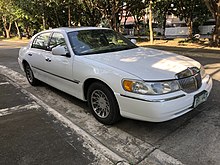
From 1998 to 2002, Ford Philippines offered the Lincoln Town Car and sold it through its dealerships. It became popular among limousine operators and funeral homes who often converted them into hearses.
Opel[]
Opel, along with Ford, were the two most popular non-Japanese car companies in the 1960s and 1970s. However, the company pulled out of the country after Martial Law was imposed by the Marcos Administration. Opel returned to the Philippines in the mid-1990s with the Astra, Vectra, and Omega, with good sales as a cheap alternative to Japanese cars, but was taken out of the country by its distributor GM Auto Traders to make way for Chevrolet's then-brand-new line up (which basically replaced all the cars Opel was selling). An example of this is the Chevrolet Zafira. Despite being an Opel-based car, it was sold alongside the Opel Astra until the brand's discontinuation in the country. Opel Vectras and Astras are still a common sight to see on the roads of Manila, with the Opel Tigra and the Opel Manta is popular among enthusiasts.
Proton[]
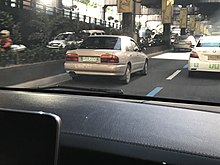
The Malaysian firm Proton only sold the Wira[41][42] before the Asian Economic Crisis forced them out of the country.
Renault[]
In the late 1970s, some Renault models were imported into the country. In 1996, a dealership in Metro Manila imported several Renault models. It failed as it was deemed too expensive.[citation needed]
Smart[]
The lightweight Smart ForTwo city car was supposed to be ideal for Manila's congested roads but failed due to its relatively high price. It did remain slightly popular with companies who used them for advertising. The ForTwo and the Roadster were both sold by CATS Motors.
Ssangyong[]
In the 1990s, SsangYong became popular for their Musso SUV and the Istana-based MB100 van – both of which were marketed as Mercedes-Benz vehicles. The brand pulled out of the Philippine market in 2012. In January 2016, Ssangyong came back into the Philippine Market with their new distributor, Berjaya Group Malaysia.[43]
Vauxhall and Holden[]
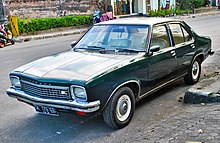
Vauxhall also made cars in the local market during the 1960s. The cars they have sold locally are the Vauxhall Viva and the Vauxhall Victor.
The Australian car manufacturer Holden also assembled a couple of cars in the country during the 1960s and the 1970s, with the Holden Torana being one of the most popular models.
Imported vehicles (Gray market)[]

Specialty dealerships across the country import various new vehicles from several countries such as South Korea, the US, and UAE. In some cases, select authorized dealerships may also use indent orders to import vehicles or trims that aren't part of their official inventory. As an example, Ford sold the Lincoln Navigator to a select group of buyers years after the Lincoln brand had been phased out of the market.[44] Some brands can only be acquired through grey import dealers such as Hummer and Cadillac. Due to the popularity of the Cadillac Escalade in the grey import market, GM Philippines considered bringing the brand to the Philippine market,[45] but would likely fail due to the competitive market for luxury SUVs. US-Market Toyotas such as the Sienna are also imported into the country, as well as the J70 Series Land Cruiser from the Middle East. Despite a Genesis G90 being shown at MIAS in 2017,[46] Most Genesis vehicles today are still sold by grey importers.
In addition, many pre-owned vehicles are imported from Japan, or Hong Kong – countries that use right-hand-drive vehicles on the left side of the road. Because right-hand-drive vehicles are banned in the country, they are converted to left-hand-drive in conversion bays and freeport zones in Subic, Santa Ana, and Toledo. These vehicles are seen with plate numbers R for Subic, B for Cagayan, K for Cagayan De Oro, and Y for Cebu. Smuggling of used cars is rampant, with as many as sixty percent of registrations being of cars not officially imported.[47]
Vehicle Smuggling[]

The country made headlines in 2007 when president Gloria Macapagal Arroyo ordered the immediate destruction of 18 luxury vehicles that were illegally smuggled into the country. The cars, which included four BMWs and a Lincoln Navigator, were crushed by backhoes and other heavy construction vehicles at a depot in the Freeport Zone.[48]
Since 2018, there have been a series of public destruction of contraband luxury vehicles under the order of President Rodrigo Duterte as part of an anti-corruption movement in the government. The Bureau of Customs have destroyed illegally smuggled cars worth millions of dollars using backhoes and bulldozers. Cars included Mercedes-Benzes, BMWs, Alpinas, Ferraris, Jaguars, Lamborghinis, Porsches, a C3 Corvette Stingray. The most recent one being a Mclaren 620R. The car was seized in Port of Manila in 2020 and was destroyed a year later in June 2021 along with other vehicles.[49][50]
Politicians have shown concerns about the destroyed vehicles. Koko Pimentel suggested that the seized luxury cars should be auctioned to foreign buyers and collectors rather than destroying them, and the profits would then be used to help victims of natural disasters in the Philippines.[51]
Vehicles currently manufactured in the Philippines[]
Toyota: Vios, Innova
Mitsubishi: L300, Mirage, Mirage G4
Fuso: Fuso Canter, Fuso FK/FL/FM, Fuso FI, Fuso FJ, Rosa, Fuso FP/FV
Hyundai: Accent, H100, H350
Hyundai Trucks and Buses: HD36, HD65, HD65X, HD78, Xcient, Super Aero City, Universe
Kia: K2500 Karga
Foton: Toplander, Thunder, View Ambulance, View Transvan, View Traveller, Toano, Gratour MT, Gratour TM, Harabas TM 300, Tornado, Auman Series Trucks
Isuzu Trucks: Q-Series, N-Series, F-Series, C/E-Series
Isuzu Buses: PABFVR34P, PABFTR33P, LV123, LV423, Mini Bus, NQR
Hino Trucks: 300 Series, 500 Series, 700 Series
Hino Buses: RC421(ER200), RF821(EK100), RM2KSS (K13D), RK3HS (H07D), RK1JMT (J08C-TK), RK1JST (J08C-TK), RM2PSS (P11C-TH), RU2PSS (P11C-TE), RK8JMUA (J08E-UB), RK8JSUA (J08E-UB), RN8J (J08E-UB), FB2W, FB4J, FC3J, FC9JL7A (J05E-TY), FF3H (H06D)AK174, (EH700)AK176 (EH700), FG8JPSB (J08E-UG), FG1JPUB (J08C-F), FG1JPUZ (J08C-TT), FG8JPUB (J08E-UG), FG8JP7A (J08E-WF), HT223A (M10U), HT225A (M10U), SH2P, SH1E, SS2P, SS1E
JMC: Hunter, Orion, Vigor, Transporter, Compadre, N700, N720
Daewoo Bus: BV115, BF106, BS106, BH117H, BS120S
Dongfeng: Captain E, Captain N, Captain D9, KD6Z, K04U, K47H, K23W, KW46, TW37, K37F
MAN: TGS, CLA, Lion's Chassis, Lion's City, Lion's Coach, Lion's Intercity
Statistics[]
Historical sales rank[]
| Top 10 best-selling vehicles in the Philippines, 1995–2020 Source: BSCB[52] AutoDeal PH[53][54] AutoIndustriya.com[55][56][57] | ||||||||||
|---|---|---|---|---|---|---|---|---|---|---|
| Year | Models and ranking | |||||||||
| 1st | 2nd | 3rd | 4th | 5th | 6th | 7th | 8th | 9th | 10th | |
| 1995 | Toyota Corolla | Toyota Tamaraw FX | Nissan Sentra | Mitsubishi Lancer | Toyota Corona | Toyota Crown | Mitsubishi Galant | Toyota LiteAce | Mitsubishi L300 | Isuzu KB/Fuego |
| 1996 | Toyota Corolla | Honda Civic | Toyota Tamaraw FX | Mitsubishi Lancer | Toyota Corona | Mitsubishi L300 | Mitsubishi Galant | Toyota LiteAce | Toyota Crown | Isuzu KB/Fuego |
| 1997 | Toyota Corolla | Toyota Tamaraw FX | Mitsubishi Lancer | Toyota Corona | Nissan Sentra | Mitsubishi Galant | Nissan Cefiro | Isuzu KB/Fuego | Toyota LiteAce | Isuzu Hi-Lander |
| 1998 | Toyota Corolla | Honda Civic | Mitsubishi Adventure | Toyota Revo | Nissan Sentra | Isuzu Hi-Lander | Mitsubishi Lancer | Toyota Corona | Mitsubishi Galant | Toyota Camry |
| 1999 | Toyota Revo | Honda Civic | Toyota Corolla | Mitsubishi Adventure | Nissan Sentra | Honda CR-V | Toyota Camry | Isuzu Hi-Lander | Mitsubishi Lancer | Mitsubishi Pajero |
| 2000 | Toyota Revo | Mitsubishi Adventure | Honda Civic | Toyota Corolla | Isuzu Hi-Lander | Nissan Sentra Exalta | Honda City | Toyota HiAce | Honda CR-V | Mitsubishi L300 |
| 2001 | Toyota Revo | Honda Civic | Isuzu Hi-Lander/Hi-Lander Crossiwind | Toyota Corolla/Corolla Altis | Mitsubishi Adventure | Nissan Sentra Exalta | Mitsubishi Lancer | Toyota Camry | Mitsubishi Pajero | Ford Lynx |
| 2002 | Toyota Revo | Isuzu Hi-Lander Crosswind | Honda CR-V | Mitsubishi Adventure | Toyota Corolla Altis | Toyota Camry | Isuzu Hi-Lander Crosswind | Nissan Sentra Exalta | Ford Lynx | Mitsubishi Lancer |
| 2003 | Toyota Revo | Honda CR-V | Toyota Corolla Altis | Mitsubishi Adventure | Ford Escape | Toyota Camry | Isuzu Hi-Lander Crosswind | Ford Lynx | Mitsubishi Lancer | Toyota Vios |
| 2004 | Toyota Revo | Toyota Corolla Altis | Isuzu Hi-Lander Crosswind | Mitsubishi Adventure | Toyota Camry | Ford Escape | Toyota Vios | Nissan Sentra | Mitsubishi Lancer | Ford Lynx |
| 2005 | Toyota Innova | Toyota Vios | Mitsubishi Adventure | Isuzu Crosswind | Toyota Corolla Altis | Toyota Fortuner | Toyota Camry | Ford Escape | Mitsubishi Lancer | Nissan Sentra |
| 2006 | Toyota Innova | Toyota Vios | Toyota Fortuner | Isuzu Alterra | Mitsubishi Adventure | Mitsubishi L300 | Honda Civic | Isuzu Crosswind | Toyota Corolla Altis | Toyota Camry |
| 2007 | Toyota Innova | Toyota Vios | Mitsubishi Adventure | Toyota Fortuner | Toyota Avanza | Isuzu Crosswind | Toyota Hilux | Isuzu D-Max | Mitsubishi L300 | Honda Civic |
| 2008 | Toyota Vios | Toyota Innova | Toyota Fortuner | Toyota Avanza | Isuzu Crosswind | Honda Civic | Mitsubishi Adventure | Toyota Hilux | Honda Jazz | Toyota Corolla Altis |
| 2009 | Toyota Vios | Toyota Innova | Honda City | Mitsubishi Montero Sport | Toyota Fortuner | Isuzu Crosswind | Honda Jazz | Honda Civic | Toyota Hilux | Toyota Corolla Altis |
| 2010 | Toyota Vios | Toyota Innova | Mitsubishi Montero Sport | Honda City | Toyota Fortuner | Toyota Hilux | Honda Civic | Toyota Corolla Altis | Honda Jazz | Mitsubishi L300 |
| 2011 | Toyota Vios | Toyota Innova | Mitsubishi Montero Sport | Toyota Fortuner | Toyota Hilux | Honda City | Honda Jazz | Isuzu Crosswind | Honda Civic | Toyota Corolla Altis |
| 2012 | Toyota Vios | Toyota Innova | Mitsubishi Montero Sport | Toyota Fortuner | Toyota Hilux | Toyota Avanza | Honda City | Honda Jazz | Toyota Corolla Altis | Isuzu Crosswind |
| 2013 | Toyota Vios | Mitsubishi Montero Sport | Toyota Innova | Toyota Fortuner | Toyota Avanza | Mitsubishi Mirage | Toyota Hilux | Honda City | Isuzu Crosswind | Toyota Corolla Altis |
| 2014 | Toyota Vios | Toyota Fortuner | Toyota Innova | Mitsubishi Montero Sport | Toyota HiAce | Toyota Wigo | Ford Ranger | Toyota Avanza | Honda City | Toyota Hilux |
| 2015 | Toyota Vios | Toyota Innova | Toyota HiAce | Mitsubishi Montero Sport | Toyota Fortuner | Toyota Wigo | Ford Ranger | Toyota Hilux | Ford EcoSport | Mitsubishi Mirage G4 |
| 2016 | Toyota Vios | Toyota Fortuner | Toyota HiAce | Toyota Wigo | Toyota Innova | Toyota Avanza | Mitsubishi Mirage G4 | Ford Everest | Toyota Hilux | Hyundai Accent |
| 2017 | Toyota Fortuner | Toyota Vios | Toyota Innova | Toyota HiAce | Mitsubishi Montero Sport | Toyota Wigo | Toyota Avanza | Toyota Hilux | Mitsubishi L300 | Isuzu MU-X |
| 2018 | Toyota Vios | Toyota Fortuner | Toyota Wigo | Toyota Hilux | Toyota Innova | Toyota HiAce | Mitsubishi Montero Sport | Nissan Navara | Mitsubishi Mirage G4 | Mitsubishi Xpander |
| 2019 | Toyota Vios | Toyota Hilux | Toyota Innova | Toyota Fortuner | Mitsubishi Xpander | Nissan Navara | Toyota HiAce | Toyota Wigo | Mitsubishi Mirage G4 | Toyota Rush |
| 2020 | Toyota Vios | Toyota Hilux | Toyota Wigo | Toyota Innova | Toyota HiAce | Toyota Rush | Ford Ranger | Nissan Navara | Mitsubishi Mirage G4 | Toyota Fortuner |
| 1st | 2nd | 3rd | 4th | 5th | 6th | 7th | 8th | 9th | 10th | |
| Locally built vehicles Imported vehicles Note: 1. The Sentra Exalta from the 2000 model year is based on the B14 Sentra, while the 2001 model year is now a rebadged Nissan Bluebird Sylphy. 2. The Corolla E110 and the Corolla Altis share the same ranking in 2001, as both models were sold together until 2005. | ||||||||||
See also : Best-selling models in
| ||||||||||
Sales by brand[]
| Rank | Brand | Sales | Market share |
|---|---|---|---|
| 1 | Toyota | 99,545 | 40.7% |
| 2 | Mitsubishi Motors | 37,366 | 15.3% |
| 3 | Nissan | 21,751 | 8.9% |
| 4 | Hyundai | 16,346 | 6.7% |
| 5 | Suzuki | 15,515 | 6.3% |
| 6 | Ford | 14,775 | 6.0% |
| 7 | Honda | 11,711 | 4.8% |
| 8 | Isuzu | 11,240 | 4.6% |
| 9 | MG Motor | 3,432 | 1.4% |
| 10 | Foton | 2,456 | 1.0% |
| others | 10,480 | 4.3% | |
| Total | 244,617 | 100% | |
| Rank | Brand | Sales | Market share |
|---|---|---|---|
| 1 | Toyota | 161,385 | 39.3% |
| 2 | Mitsubishi Motors | 64,065 | 15.6% |
| 3 | Nissan | 42,694 | 10.4% |
| 4 | Hyundai | 32,856 | 8.0% |
| 5 | Suzuki | 23,919 | 5.8% |
| 6 | Ford | 21,900 | 5.3% |
| 7 | Honda | 20,338 | 5.0% |
| 8 | Isuzu | 13,971 | 3.4% |
| 9 | MG Motor | 5,085 | 1.2% |
| 10 | Foton | 4,293 | 1.0% |
| others | 19,681 | 4.8% | |
| Total | 410,187 | 100% | |
See also[]
- Economy of the Philippines
- Transportation in the Philippines
References[]
- ^ cycles, This text provides general information Statista assumes no liability for the information given being complete or correct Due to varying update; Text, Statistics Can Display More up-to-Date Data Than Referenced in the. "Topic: Automotive industry in the Philippines". Statista.
- ^ https://boi.gov.ph/wp-content/uploads/2018/02/Automotive-July-3-2017.pdf
- ^ "Automotive".
- ^ "Philippines: cost difference of CBU vehicles compared to locally produced cars, by source country". Statista.
- ^ https://www.topgear.com.ph/features/feature-articles/Philippine-cars-cost-history-a52-20180209
- ^ "What were the first car dealerships in the Philippines?". www.topgear.com.ph.
- ^ Jump up to: a b c d e f g https://www.eria.org/ERIA-DP-2015-09.pdf
- ^ https://oldmanila.org/2018/03/05/cars-of-old-manila/
- ^ Ofreneo, Rene E. (2008-07-21), "Arrested Development: Multinationals, TRIMs and the Philippines' Automotive Industry", in Rasiah, Rajah; et al. (eds.), Multinationals, Technology and Localization in Automotive Firms in Asia, Routledge, ISBN 978-0415440677
- ^ Jump up to: a b c d e "Looking back: 32 years of the auto industry". motioncars.inquirer.net.
- ^ Jump up to: a b "Once there was a PCMP".
- ^ Jump up to: a b c "Made in the Philippines: Cars that proudly flew the flag - Feature Stories". AutoIndustriya.com. June 12, 2018.
- ^ Guno, Charmaine Samala; Collera, Angelie Azcuna; Agaton, Casper Boongaling (2021). "Barriers and Drivers of Transition to Sustainable Public Transport in the Philippines". World Electric Vehicle Journal. 12 (1): 46. doi:10.3390/wevj12010046.
- ^ Jump up to: a b c d e "Auto manufacturing in the Philippines is an endangered species - Editor's Note". AutoIndustriya.com. February 27, 2020.
- ^ "Comprehensive Automotive Resurgence Strategy (CARS) Program - Securing The Future of Philippine Industries".
- ^ Gamboa, Rey. "Cars program headed for epic fail?". Philstar.com.
- ^ 31. https://mmpc.ph/pressrelease/mitsubishi-motors-philippines-approved-cars-program-participant/
- ^ "These companies will help Mitsubishi PH build the Mirage locally". www.topgear.com.ph.
- ^ https://www.autoindustriya.com/auto-industry-news/vehicles-from-thailand-japan-germany-usa-subject-to-dti-safeguard.html
- ^ https://www.autoindustriya.com/auto-industry-news/buy-a-ph-made-car-says-dti-but-what-s-left.html
- ^ https://asia.nikkei.com/Business/Automobiles/Philippine-auto-tariffs-send-chill-through-pandemic-hit-industry
- ^ https://mb.com.ph/2021/08/09/dti-stops-safeguard-duty-on-imported-cars-lcvs/
- ^ https://goflatoutph.com/2021/08/11/dtis-safeguard-duty-on-imported-cars-lcvs-to-be-suspended/
- ^ "Revered Popemobile to make the rounds of PHL churches". GMA News Online.
- ^ "Ford Philippines | The Ford Philippines Assembly Plant". April 11, 2013. Archived from the original on 2013-04-11.
- ^ "Philippines – GM Careers".
- ^ https://www.topgear.com.ph/?ref=404-autoredirect/features/feature-articles/Philippine-cars-cost-history-a52-20180524
- ^ http://www.yutivo.com/
- ^ "The forgotten father of the AUV – Harabas". Lumang Oto. Archived from the original on 2012-01-16.
- ^ https://www.topgear.com.ph/features/feature-articles/isuzu-crosswind-ends-production-a00040-20170706
- ^ https://philkotse.com/market-news/isuzu-d-max-production-in-the-philippines-discontinued-4008
- ^ "DOLE, DTI to convince Honda Cars Philippines to continue production in Laguna". GMA News Online.
- ^ https://www.autoindustriya.com/auto-industry-news/under-new-management-ayala-re-launches-kia-in-the-philippines.html
- ^ https://www.carguide.ph/2019/12/this-is-how-mazda-philippines-stores.html
- ^ https://business.inquirer.net/316212/nissan-to-shut-down-laguna-plant
- ^ https://goflatoutph.com/2013/09/30/under-the-spotlight-the-time-is-now-for-volkswagens-philippine-return/
- ^ https://www.carguide.ph/2018/06/volkswagen-philippines-ready-to-say.html
- ^ https://www.bworldonline.com/volkswagens-china-sourced-units-expected-to-grow-phl-sales-by-60/
- ^ https://visor.ph/industry/volkswagen-ph-is-frustrated-the-market-doesnt-get-it/
- ^ https://mb.com.ph/2021/03/15/volkswagen-ph-pivots-sourcing-to-china/
- ^ https://www.officialgazette.gov.ph/1995/01/28/speech-of-president-ramos-at-the-launching-of-the-proton-wira-with-prime-minister-mahathir-mohamad-of-malaysia/
- ^ https://dirp4.pids.gov.ph/ris/dps/pidsdps0042.pdf
- ^ https://www.topgear.com.ph/news/industry-news/ssangyong-to-make-grand-comeback-to-ph-market-3-models-to-be-launched-a00058-20160126?ref=tag
- ^ https://www.autoindustriya.com/auto-industry-news/order-a-lincoln-navigator-straight-from-ford-ph.html
- ^ https://www.autoindustriya.com/auto-industry-news/chevrolet-philippines-eyeing-possibility-of-cadillac-for-local-market.html
- ^ https://www.autoindustriya.com/auto-industry-news/mias-2017-hyundai-reveals-the-genesis-g90-flagship-sedan.html
- ^ Ofreneo, p. 8
- ^ Philippine Government Destroys P30 Million Worth of Smuggled Vehicles[dead link]
- ^ https://www.roadandtrack.com/news/a36765968/philippines-customs-crushed-a-mclaren-620r-dollar12-million-in-cars/
- ^ https://visor.ph/industry/boc-seizes-smuggled-limited-edition-mclaren-620r/
- ^ https://www.rappler.com/nation/koko-pimentel-review-customs-destruction-smuggled-luxury-cars
- ^ Gasnier, Matt (2011-11-14). "Philippines: 1995-2020 Historical Data now available". Best Selling Cars Blog. Retrieved 2021-03-23.
- ^ https://www.autodeal.com.ph/articles/car-news-philippines/10-best-selling-cars-in-philippines-2018
- ^ https://www.autodeal.com.ph/articles/car-features/10-best-selling-cars-in-philippines-2020
- ^ https://www.autoindustriya.com/auto-industry-news/philippines-039-10-best-selling-cars-of-2016.html
- ^ https://www.autoindustriya.com/auto-industry-news/philippines-10-best-selling-cars-in-2017.html
- ^ https://www.autoindustriya.com/auto-industry-news/here-are-the-10-best-selling-cars-in-the-philippines-of-2019.html
- ^ Sarne, V. Vernon B. "All the numbers: Philippine car sales figures in 2020". visor.ph. Retrieved 2021-02-13.
- History of transportation in the Philippines
- Automotive industry in the Philippines
- Motor vehicle manufacturers of the Philippines



